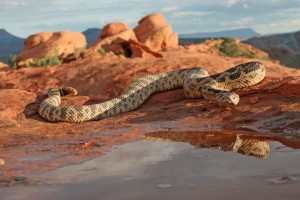
Summer means heading to surrounding mountains for gorgeous views and slightly cooler weather. But a nice day in the mountains can turn nasty when hikers encounter potentially dangerous wildlife.
Utah is home to some interesting animals. It’s important that hikers understand which animals are dangerous and which ones can be observed peacefully.
While some hikers may think of snakes, cougars or bears as the most threatening animals, Scott Root, a conservation manager with the Utah Division of Wildlife Resources, tells a different story. “Moose are actually the most dangerous animal for hikers this time of year,” he said. “A lot of times people want to get a little closer, and a little closer, and a littler closer; all just to get a better picture. And then they cross the line.” Root explained that although other animals can be dangerous, moose will probably be the most aggressive, especially if it’s a mother with her baby.
If hikers encounter an aggressive moose, they should back away and put something between themselves and the moose. Moose are fast, and getting behind something to be out of the moose’s eyesight will help prevent the hiker from being run over.
A rattlesnake is another misunderstood animal that many hikers encounter during the summer months. Rattlesnakes love the heat in the dry mountains near Provo and can terrify hikers who come across them. They are easily avoided and can be safely observed from a distance.
“If a hiker wants to avoid a rattlesnake they should stay on maintained trails, look down where they walk and not go poking around in any bushes or rocky ledges,” said Jack Sites, professor of biology and curator of herpetology at BYU. “The only species of rattlesnake found near Provo is the modest-sized and non-aggressive Great Basin rattlesnake,” he said.
Rattlesnakes are most active in the early morning, late afternoon or night, depending on the heat. The best thing to do is to simply back away if a hiker encounters a rattlesnake. “The snake will be as terrified as the person, and it will only strike if one gets too close,” Sites said. Hikers should stay calm and seek medical attention immediately if bitten; they should not try to kill the snake.
For more information on the wildlife in and around Provo, refer to http://wildlife.utah.gov/ or http://www.wildawareutah.org/.




